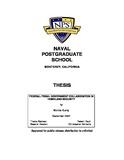Correspondence, Misunderstanding Pakistan's Federally Administered Tribal Area?
Abstract
In “No Sign until the Burst of Fire: Understanding the Pakistan-Afghanistan Frontier,”
Thomas Johnson and Chris Mason argue that Pashtun tribal identities explain the lure
of the Taliban and the shortcomings of the initial U.S. approach to the war in Afghanistan.
1 They carry this argument too far, however, and engage in cultural reductionism
by portraying the Pashtun tribal code as the determining factor behind politics and
preferences in Pakistan’s Federally Administered Tribal Area (FATA). Johnson and
Mason make the following errors: (1) treating Pashtun identity as if it were set in stone;
(2) failing to consider that today’s radical Islamists rely on different sources of support
than did the mullahs (Islamic religious leaders) who led jihads against the British Empire;
and (3) misinterpreting the role of the ofªcial maliks (tribal and village leaders) in
the FATA.
Rights
This publication is a work of the U.S. Government as defined in Title 17, United States Code, Section 101. Copyright protection is not available for this work in the United States.Collections
Related items
Showing items related by title, author, creator and subject.
-
Tribal-federal government collaboration in homeland security
Kueny, Monica R. (Monterey, California. Naval Postgraduate School, 2007-09);Each day, more than fifteen hundred illegal immigrants enter the United States through the tribal lands of the Tohono Oâ odham Nation, and more than twenty-five other tribes have land on or near the international borders ... -
ESTABLISHING STRONGER BONDS AND PREPARING FOR FUTURE DISASTERS IN TRIBAL COMMUNITIES
Bordelon, Denise R. (Monterey, CA; Naval Postgraduate School, 2022-12);Improving relationships between tribal nations and federal agencies to improve disaster management outcomes is critical because, as part of the homeland security community, tribal lands form both north and south U.S. ... -
HOMELAND SECURITY FROM A TRIBAL CONTEXT
Figueroa, Lisa M. (Monterey, CA; Naval Postgraduate School, 2018-12);A gap exists between the federal government and the 567 tribal nations, which hampers tribal inclusion in homeland security. American Indian and Alaskan Native lands comprise 100 million acres of land within the territory ...



 Johnson_Misunderstanding_2009.pdf (65.09Kb)
Johnson_Misunderstanding_2009.pdf (65.09Kb)

